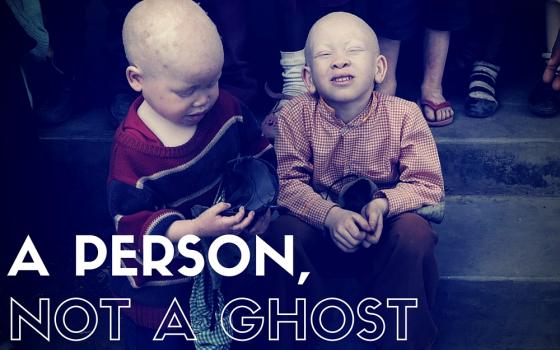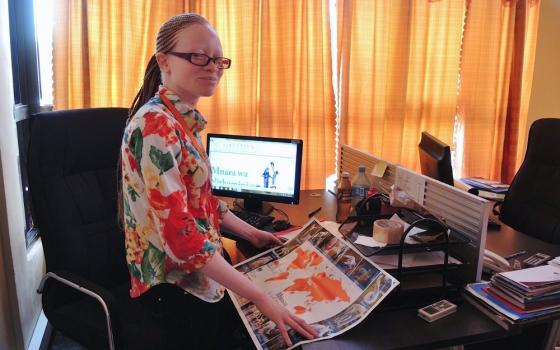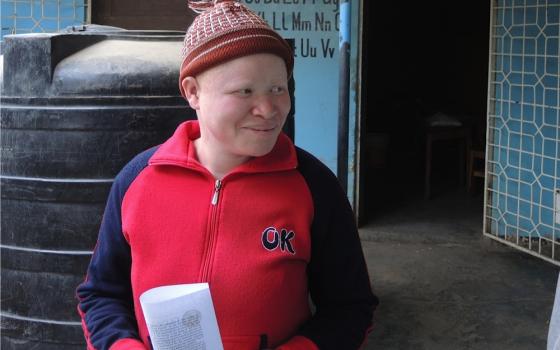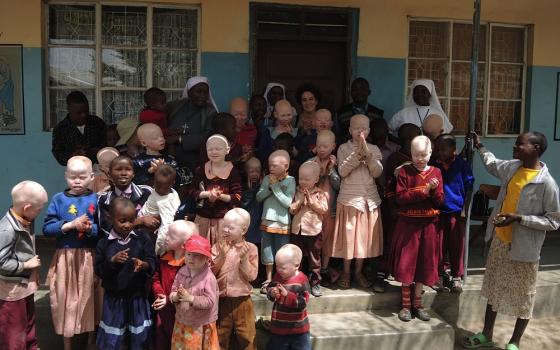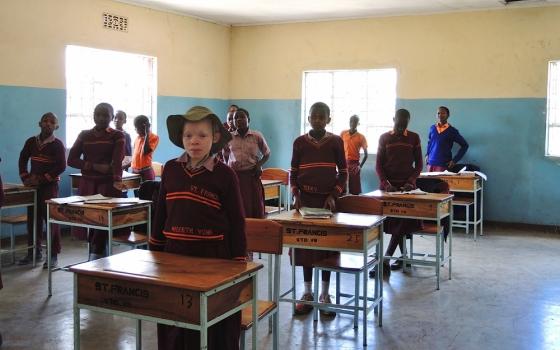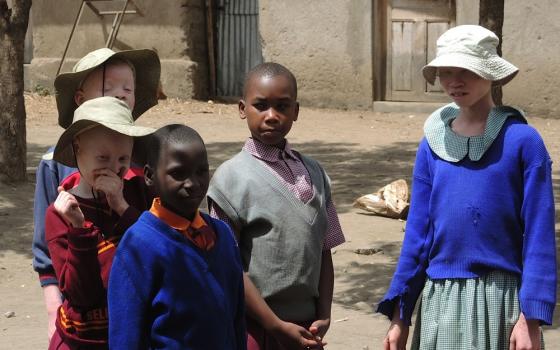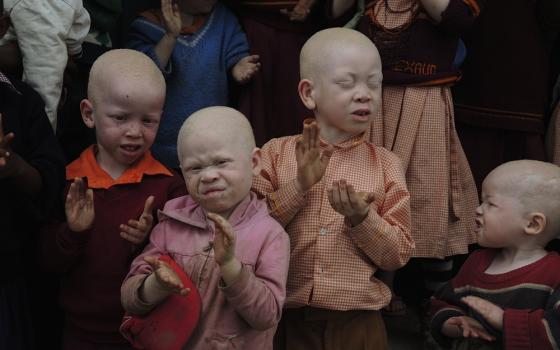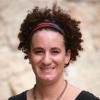Melissa Stanford is 14 years old and dreams of becoming a lawyer. The sixth-grade student lives at a residential school run by the Our Lady of Kilimanjaro Sisters in northern Tanzania, where she is at the top of her class and helps the sisters take care of the younger students, some of whom have physical disabilities. She is quiet and polite with strangers and compassionate with the younger children.
She speaks excellent English in addition to Swahili and her tribal language. She knows her pursuit of becoming a lawyer is a challenging path for any female from rural Tanzania.
But Melissa does not look like most Tanzanians. She was born with albinism, a genetic mutation that means the body is unable to produce pigment or melanin in the skin, hair or eyes. For unknown reasons, the condition is 20 times more prevalent in her region of Tanzania than in North America and Europe. And due to a lack of education, it is shrouded in mystery and superstition in Tanzania and surrounding countries, leaving people with albinism particularly vulnerable to attacks.
Local traditions in some parts of Africa hold that body parts of people with albinism have magical properties that can make people rich. Witchdoctors, who use the body parts in potions, have created a gruesome trade where albino limbs can fetch thousands on the black market. Since 2006, 164 people have been murdered and 264 maimed, according to Under the Same Sun, an albino-advocacy organization based in Canada and Tanzania that tracks these cases. Many more attacks go unreported.
"There have been beliefs since our grandfathers' time that people with albinism are ghosts, that people with albinism are not human beings," said Perpetua "Perry" Senkoro, a lawyer who has albinism and works at Under the Same Sun in Tanzania. "[They think] people with albinism do not die, they disappear. If I chop off their hand or their leg and bring it to a witchdoctor and he does that voodoo stuff, I can get rich."
Melissa understands the horror personally. In 2008, when she was 7 years old, two men broke into her family's house to attack her sister, Mariamu, who was 28 and also has albinism. They used a machete to chop off both of her arms. It took Mariamu seven hours to get medical attention, but she survived. Since then, both sisters have received protection and care through the Our Lady sisters and Under the Same Sun.
Activists and widespread media attention have shed light on the practice in a mission to change superstitious notions about people with albinism. A documentary called "The Boy From Geita" about Adam, a young boy with albinism who survived a vicious attack at his home in the same district as Melissa, was recently nominated for five awards, including the 2015 Director's Guild of Canada for best documentary. The film also follows Mariamu Stanford's story.
In North America and Europe, about one in every 20,000 people have some form of albinism. In Tanzania, about one in 1,400 people have the condition. Experts are not certain why the incidence is so much higher here, especially in the northwestern part of the country near Lake Victoria, where Melissa is from and where the likelihood of albinism is one in 1,000.
People with albinism have pale white skin that burns easily in the sun. In addition to the threat of attacks, they often struggle with physical challenges such as low vision and skin cancer. In Tanzania, 90 percent of those with the condition contract skin cancer by the time they are 30, according to Under the Same Sun. Due to lack of access to medical care, many of the cases are fatal.
People with albinism are at risk from witchcraft in 25 countries in Africa, including Kenya, Malawi, Burundi, Egypt and Mozambique.
According to a 2009 report from the Red Cross and Red Crescent Societies, the body of a person with albinism can command as much as U.S. $75,000 on the black market. Limbs can cost thousands of dollars. The gross national income per person in Tanzania is U.S. $920 per year.
Many of these grotesque crimes are reported in Tanzania, with 159 attacks and 76 killings since 2006. "It's not just in Tanzania, it's all over Africa, it's just that in other countries people don't speak about it so it's not widely known," said Senkoro, citing better press freedom and field research as factors in Tanzania's higher and more accurate data.
After the attack on her sister, Melissa fled her family's home and has never returned. A social worker brought her to the St. Francis School in Moshi, where Under the Same Sun sponsors her tuition. The Our Lady Sisters also housed and assisted Mariamu during part of her rehabilitation. Mariamu attended a vocational school in Moshi and learned how to knit sweaters using two prostheses. She now lives in Dar es Salaam, while Melissa stayed in Moshi.
"I want to become a lawyer after I finish secondary school, because I want to study security laws to protect albinos," Melissa said. "I want to tell people not to believe in witchcraft, but it is not so easy to change their minds."
'The fence is not high enough'
The St. Francis of Assisi School for the Abled and Disabled, run by the Our Lady of Kilimanjaro Sisters, is located in a pastoral village on the highway from Arusha to Moshi, the popular tourism destination that is the jump-off point for treks to Mount Kilimanjaro or safaris in the Serengeti National Park.
The school has 268 students, 42 of whom have albinism and issues with low vision. Other students have disabilities, including deafness, total blindness and birth defects, and some have no disabilities but are orphans or children from disadvantaged backgrounds. The school puts an emphasis on teaching all the children together.
"When we are inclusive, it helps the children because there's interaction," said Sr. Mary Benedicta Mosha, the director of St. Francis. "When they're studying alone, they feel inferiority. They think, 'Well, I can't see, so I won't work, I'll just wait for someone to help me.' But here, they go together, they play together, and they help each other."
The residential school offers a solution to children with albinism who were not attending school. Some were the victims of attacks or had family members who were attacked. Others were kept home purposefully, either because the parents were ashamed or scared.
Even at the school, the students with albinism are still at risk for kidnapping or attacks. "Here there is a problem with security, the fence is not high enough, people can just jump over it," said Mosha. "So we take turns — nuns, teachers, caretakers — to sleep outside to make sure that the albinos are safe."
Mosha knows that it's not really about building a better wall, which is only a short-term solution. The real mission is to change people's perceptions.
Humanizing people with albinism, village by village
Peter Ash, a Canadian pastor and real estate entrepreneur who also has albinism, founded Under the Same Sun in 2009. The organization aims to bring the issue of attacks against people with albinism to wider attention in Tanzania and around the world. One approach is through sponsored TV commercials and radio spots in Tanzania, featuring people with albinism talking about their lives and fears.
But the thrust of their advocacy is done in the most remote parts of the country, going village by village to explain what causes albinism. The discrimination stems from the fact that few people understand what causes the condition, they say.
Albinism is a genetic mutation that happens when both parents are carriers of the albinism trait. If parents have normal pigmentation but both carry the recessive gene, the child has a 25 percent chance of having albinism.
Under the Same Sun visits a different region of Tanzania every three months, traveling to at least 10 villages and making presentations for 500 to 3,000 people. The seminars combat misinformation, like the belief that, if you rape a person with albinism, you'll be cured of AIDS. The activists have also encountered situations where doctors refuse to treat patients with albinism because they're worried about becoming infected themselves (genetic conditions are not infectious). But the biggest step towards humanizing albinism is simply introducing communities to successful, educated, confident people with albinism.
"The first time we went out for a seminar about albinism, we were afraid of taking people with albinism with us to remote villages," said Vicky Ntetema, a former BBC journalist who was one of the first to investigate the phenomenon and bring the atrocities to a world stage. Ntetema won the International Women's Media Foundation award for Courage in Journalism in 2010 for her work exposing the killings. "But when Perpetua, for example, stands there and says 'I have albinism, I am educated, I went to school, I faced challenges but I went to school,'" explained Ntetema, "She says, 'Here I am, I'm a lawyer.' And people go 'What?! So they're intelligent also? So they can go to school?!'"
"People with albinism lack [self-esteem] because from the time they were born, fingers pointed at them — 'There goes a ghost, there goes a curse, there goes a stupid person,'" Ntetema continued. "These people cannot do anything, they're just a burden to their parents and their community.' If you're a curse then every natural disaster that's happening in your area in your community is your fault. You are to blame."
The "a-ha!" moment at the village training sessions, when people start to grasp that people with albinism do not have black magic powers, comes when the presenters bring out a poster showing how albinism occurs in every living thing. "When we say that there are animals with albinism, and plants with albinism, people are like, 'wow,'" said Senkoro.
In areas where albinism is prevalent, it's also important to educate parents and teachers about the disabilities that can come as a result of the mutation.
One of the characteristics is low vision. But when no one knows about that effect of albinism, the child struggles in school, unable to see the blackboard or follow along with the class. They often end up failing tests, forcing them to repeat grades. The students either run out of funds or get frustrated and drop out. Now the village workshops include a section for teachers on how to support students with albinism, ideas as simple as moving them closer to the blackboard.
Another serious issue is skin cancer. It is treatable with liquid nitrogen, if caught in the first stage, but a lack of education and access to medical services means it is often fatal. Many families are ignorant that children with albinism must wear long sleeves and hats to protect their skin, and sunscreen is too expensive for most Tanzanians.
Shining a light
Coverage in the local press is also helping to change people's minds. The headlines sound too gruesome to be true: Desperately poor parents sell their children's fingers. A child is kidnapped and sold by his uncle. But the simple fact that there are headlines in local papers is an important first step towards raising awareness, Senkoro said.
Mariamu Stanford, who now lives at a home sponsored by Under the Same Sun for victims of attacks, became a de facto spokeswoman for victims when she went to court against her attackers, one of the first to do so.
In 2014, a judge dismissed the case, claiming that, due to Mariamu's low vision, she could not have identified the attacker at night. Mariamu said she recognized the voice of her neighbor, who had lived next door for seven years and had verified her whereabouts the day before the attack.
She sees the judge's decision as another example of prejudice against people with albinism. Today, she is struggling to support herself, as the prostheses that allowed her to knit no longer fit.
Mariamu's 8-year-old son Elisha, who does not have albinism, says he wants to be a police officer when he grows up, so he can "arrest all the bad guys who hurt people with albinism," she said.
"The reason why there's a high level of stigma and discrimination is that they don't understand about albinism, they don't understand why we exist," Mariamu said. "When ordinary people understand what it is, they'll treat us like human beings."
[Melanie Lidman is Middle East and Africa correspondent for Global Sisters Report based in Israel.]
